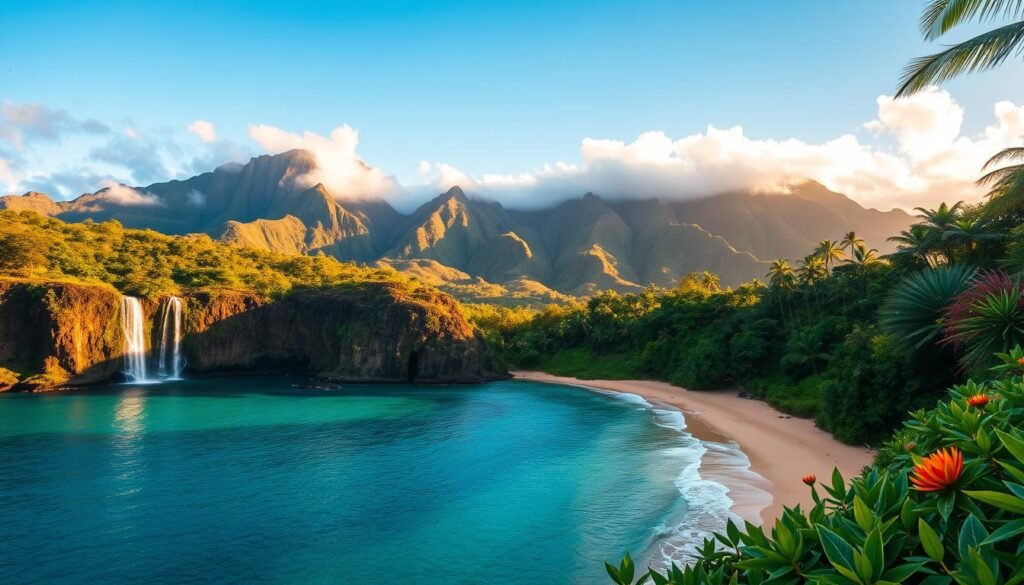Surprising fact: nearly half the island is rugged, largely inaccessible forest and cliffs best seen from a helicopter — that scale changes how you plan a trip.
I fell for this place at first sight: lush valleys, cathedral cliffs, and an easy mix of epic hikes and gentle beach afternoons that make the island feel like one of the best places on earth.
I’ll set clear expectations for timing, permits, and shuttles so you won’t waste time. Seasonal factors matter: summer boat tours offer calmer seas and cave access, and helicopter flights after rain reveal extra waterfalls.
Practical tips: plan permits for Hāʻena and Kalalau, use drive-up viewpoints at Waimea Canyon and Kōkeʻe for huge payoffs, and respect wildlife — keep distance and follow Leave No Trace.
How I paced my days: sunrise lookouts, mid-day refuel stops, and golden-hour viewpoints. I balance marquee sights with low-key spots so the beauty feels relaxed, not rushed.
For more planning details and route ideas, see this guide: detailed trip guide.
Key Takeaways
- Rugged interiors are often best viewed by helicopter for true scale.
- Reserve permits and shuttles ahead for Kalalau and Hāʻena access.
- Season affects boat and flight experiences—plan around calmer seas or recent rains.
- Use drive-up viewpoints at Waimea Canyon and Kōkeʻe for big rewards with less effort.
- Prioritize safety: secure valuables, keep safe distances from wildlife, and follow Leave No Trace.
Best things to do in Kauai
Start your best day by pairing a Nā Pali Coast experience with a mellow North Shore afternoon. I plan mornings for big, scenic moments and afternoons for sandy resets.
Nāpali Coast by boat or helicopter
I chose boat tours from Port Allen for summer sea-cave access and helicopters when recent rains promised extra waterfalls. Doors-off flights reveal Jurassic Falls; boats let you snorkel and approach cliffs.
Ridge and waterfall hikes
For panoramic ridge views, I hike Awaʻawapuhi (6.6 miles). For dramatic falls, Hanakāpīʻai on the Kalalau Trail is an unforgettable 8-mile route that needs Hāʻena State Park reservations and shuttle planning.You can learn more best-places-to-visit-in-spain
Slow afternoons on the North Shore
My go-to beach circuit: Tunnels via Hāʻena Beach Park, Kēʻē at golden hour, and Hanalei Bay for sunset. Each spot offers different protection and parking ease, so pick the one that fits your energy level.
- Morning: Nā Pali flight or Port Allen cruise for cliff-line views.
- Afternoon: Short ridge hike or a relaxed beach picnic at a protected bay.
- Golden hour: Kēʻē or Hanalei for cinematic light.
“I planned a morning cliff experience, then a calm beach park — that balance made the island feel both epic and restful.”
| Season | Best cliff option | Best beach spot | Family-friendly? |
|---|---|---|---|
| Summer | Boat tour (sea caves) | Tunnels (protected water) | Yes |
| Winter | Helicopter (waterfall views) | Hanalei Bay (sheltered sunset) | Mostly |
| Shoulder | Either (calmer seas variable) | Kēʻē (golden hour) | Yes |
Nāpali Coast adventures: boat tours, sea caves, and summer snorkeling
![]()
I booked a south-side departure from Port Allen and watched the coast reshape as we moved toward those towering cliffs. Summer offered calm seas and access to sea caves; winter meant closer waterfall views by air.You can learn more best-time-to-visit-yosemite
When to pick a boat tour versus a helicopter
Boat tour: best in summer when the sea is calm. Cruises run about 4–5.5 hours and some sunset options include dinner and drinks.
Helicopter: favors winter storms—the higher water flow makes waterfall showings dramatic from above.
What you’ll likely see on the water and from the sky
Dolphins often escort boats and the ocean can be mirror-smooth on good days. The cathedral cliffs rise sheer from the sea and sea caves open in summer for quick snorkel stops.You can learn more best-places-to-visit-in-switzerland
Practical tips for comfort and logistics
Outbound legs can be bumpy; some people get seasick, so pack motion remedies. Parking is at Port Allen—arrive early for easy check-in. Bring layers for wind and a light waterproof.
“I found golden-hour departures best for sculpted light, but sunrise runs are quieter if you want fewer boats on the water.”
- Typical cost: $210–$250 per person depending on inclusions and season.
- Runtime: 4–5.5 hours for standard and sunset cruises.
- Decision helper: choose a boat for caves and snorkeling in summer; choose a heli for winter waterfalls and dramatic aerials.
| Option | Best season | Highlights | Notes |
|---|---|---|---|
| Boat tour (Port Allen) | Summer | Sea caves, snorkeling, dolphins | 4–5.5 hrs; sunset cruises often include dinner |
| Helicopter flight | Winter | Waterfalls, aerial cliff views | Best after rain; doors-off for photos |
| Sunrise vs. Sunset cruise | Shoulder | Quiet mornings vs. golden light | Pick sunrise for fewer people, sunset for dramatic color |
Helicopter tours over Waimea Canyon and Jurassic Falls
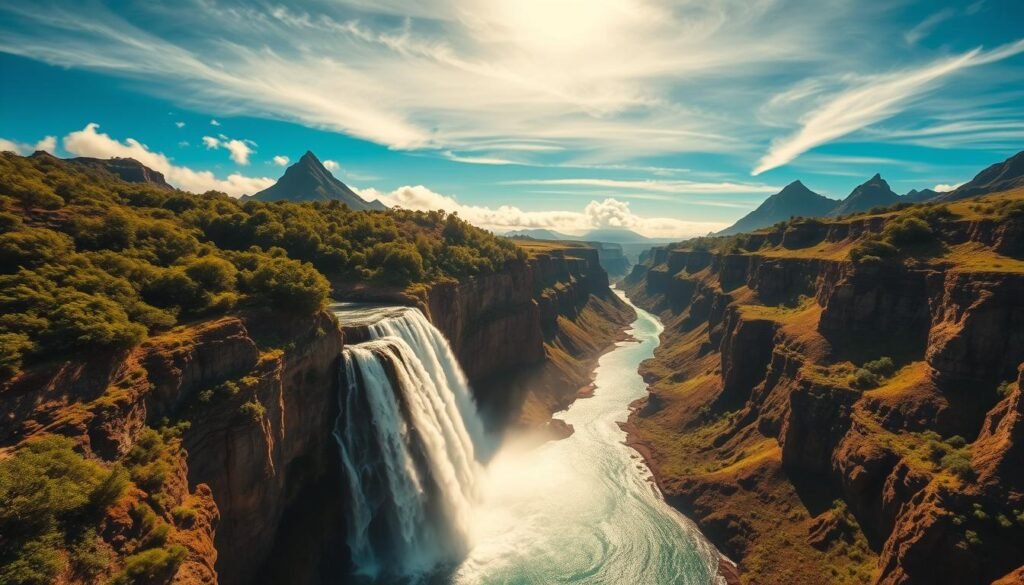
The first time a chopper banked above Jurassic Falls, the canyon felt like another world.
Why fly? A roughly one-hour flight (about $400 per person) opens terrain that is otherwise unreachable. I saw amphitheaters, razorback ridges, and Manawaiopuna (Jurassic) Falls in a single pass.
Doors-off versus standard flights and best aerial viewpoints
Doors-off flights gave me clearer, unobstructed views into canyon bowls and narrow ridgelines. Standard tours are quieter and warmer, which some people prefer.
Flights often circle clockwise. That can make the left-side seat less ideal for Nā Pali views, so I asked when booking for a seat choice.
Photography tips: lenses, seating, and timing after rain
I left my ultra-wide at home and used a 24–70mm (24–105mm works too). These lenses framed waterfalls and canyon textures without edge distortion.
Plan time right after storms. Waterfalls swell and the fluted cliffs look most dramatic then.
“The doors-off run let me photograph plunging falls and deep canyon shadows without glass glare.”
- Cost & time: ~1 hour, about $400 per person.
- Gear: 24–70mm or 24–105mm. Secure straps and compact cases.
- Comfort: wind layers, ear protection, and a small bag for fast access.
| Feature | Why it matters | My tip |
|---|---|---|
| Doors-off | Clear views, no window glare | Choose doors-off for photos; wear secure straps |
| Standard | Warmer, quieter flight | Better if you prefer less wind and noise |
| Timing after rain | Higher waterfall volume and richer colors | Book within 24–48 hours after storms |
Waimea Canyon and Kōkeʻe State Park: the Garden Island’s grand drive
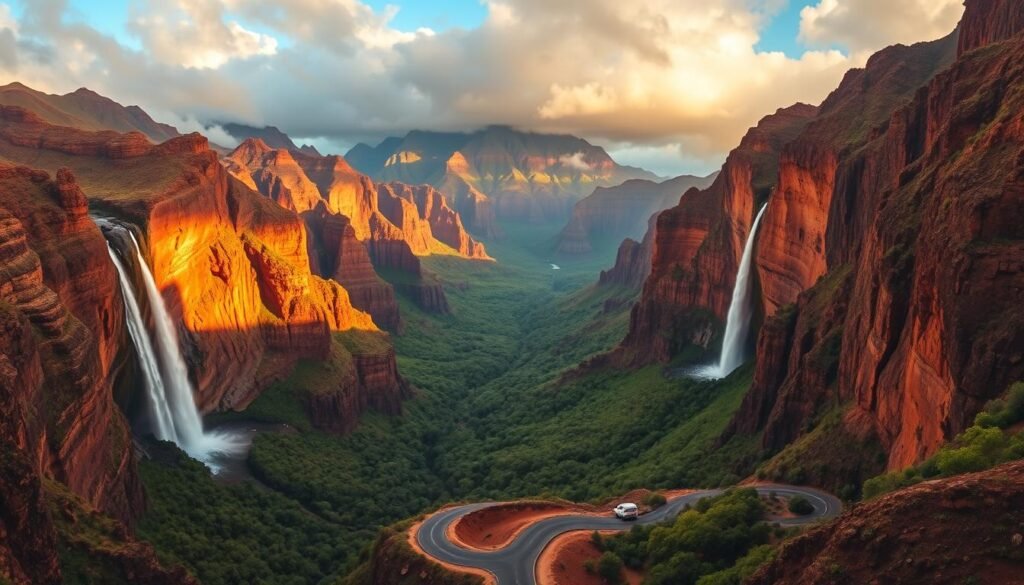
I map a 19-mile run up the Kōkeʻe–Waimea Canyon Road that stitches lookouts and short hikes into one grand loop. I start early to beat clouds and snag the clearest views.
Scenic pullouts I use
I hit Waimea Canyon Lookout first, then a quick stop at Red Dirt Waterfall, Kalalau Lookout, and finish at Puʻu O Kila. Paid parking at main spots is about $10, plus a $5 per person entry fee for the state park.
Short stops with huge payoff
The Iliau Nature Loop is only 0.4 miles and packs big canyon context. These short walks are perfect when you want a photo spot without committing miles of hiking.
Trail ideas and pacing
Pick Awaʻawapuhi for ridge drama (6.6 miles), Nualolo for a workout (~7.5 miles, ~2,500 ft gain), or the Canyon Trail to Waipoʻo Falls for a moderate ~3-mile round trip. I decide based on time, energy, and cloud cover.
“Go early, plan snacks and layers, and be ready to pivot if the weather closes the canyon.”
| Stop | Distance/Time | Why I pick it |
|---|---|---|
| Waimea Canyon Lookout | Short pullout | Immediate, sweeping waimea canyon views |
| Iliau Nature Loop | 0.4 miles | Fast payoff, great lighting later in morning |
| Canyon Trail → Waipoʻo Falls | ~3 miles RT | Moderate hike with waterfall finish |
Hikes I love: ridge lines, waterfalls, and coastal views
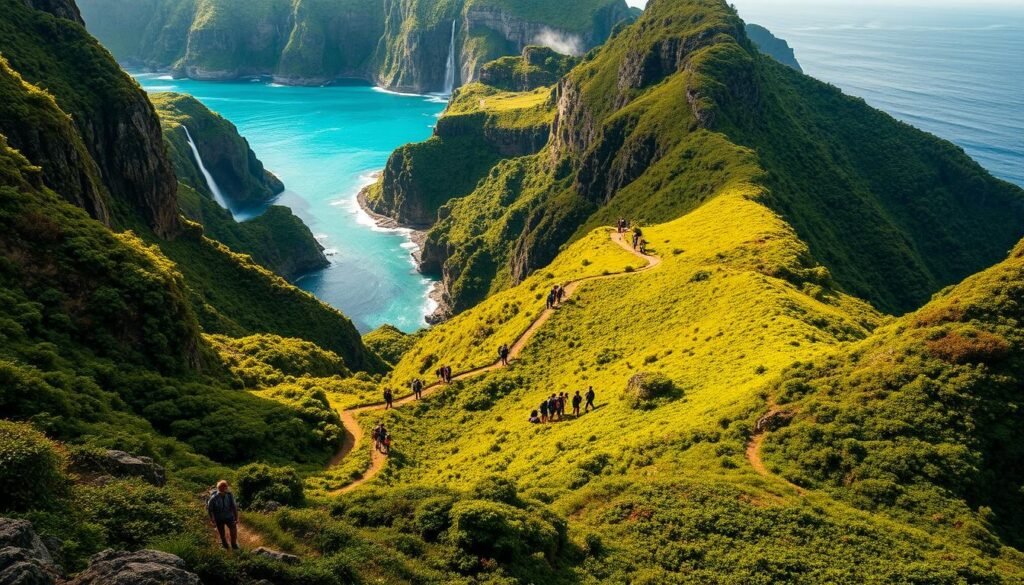
I pick one ridge hike each trip that guarantees a jaw-dropping panorama at the end.
Awaʻawapuhi Trail — ridgeline sunset stunner
The Awaʻawapuhi Trail is 6.6 miles round trip and became one favorite for me. I time this hike for late afternoon so the ridgeline glows at sunset.
Hanakāpīʻai Beach and Falls — Kalalau logistics
Hanakāpīʻai is ~8 miles round trip off the Kalalau Trail. Reserve Hāʻena shuttle or parking ahead, budget for muddy sections and river crossings, and bring an early start window for safe turnaround.
Kuilau Ridge and Sleeping Giant — easy wins
Kuilau Ridge Trail runs about 3.4 miles with a gentle grade — ideal for family mileage. Sleeping Giant offers 2.2–3.8 miles via East or West routes and rewards sunrise or sunset efforts.
Weeping Wall (Mt. Waiʻaleʻale) — expert-only
The Weeping Wall route is ~6.2 miles and brutally weather-dependent. I only attempt this with local beta and perfect conditions; it’s an expert adventure for tough terrain and big rain events.
“Keep trekking poles for slick descents, stay on marked paths, and pack a pivot plan in case closures hit.”
| Trail | Distance | Why I pick it |
|---|---|---|
| Awaʻawapuhi Trail | 6.6 miles RT | Ridgeline views; sunset payoff |
| Hanakāpīʻai (Kalalau) | ~8 miles RT | Beach and waterfalls; shuttle required |
| Kuilau Ridge | 3.4 miles | Family-friendly, mellow grade |
| Sleeping Giant (Nounou) | 2.2–3.8 miles | Short, rewarding sunrise hikes |
North Shore beaches and bays: Tunnels, Kēʻē, and Hanalei sunsets
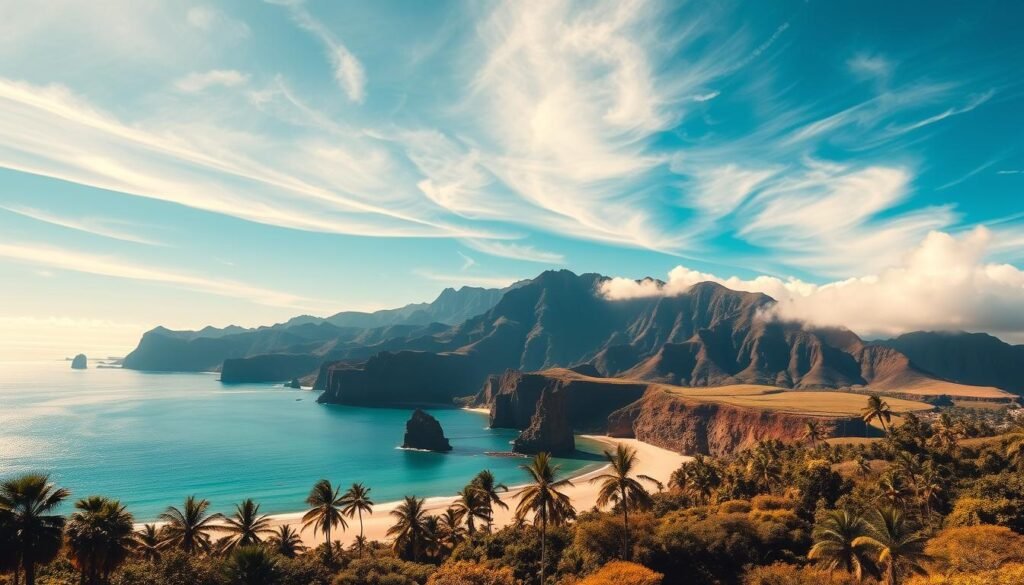
A North Shore afternoon can turn small plans into memory-rich moments when the light hits the cliffs just right.
Tunnels access and where I park
I park at Hāʻena Beach Park when spaces are open and walk along the sand toward Mākua (Tunnels). This short stroll is the easiest way to find a quiet spot and good snorkeling.
Kēʻē at golden hour
Kēʻē sits inside Hāʻena State Park and requires reservations. I time visits for late afternoon when the Nā Pali views glow and many hikers have cleared out. It became my regular day-ending ritual.
Hanalei sunset routine
Hanalei Bay has easy parking if you arrive early. I bring snacks, watch the light, and look back at the mountains—after rain you often see waterfalls ribboning down.
Wildlife note: turtles sometimes rest on nearby shores—always keep distance and respect reef safety.
“If parking is tight, arrive earlier or return after dinner; evening turnover frees up safe, legal spaces.”
| Spot | Access | Why I pick it |
|---|---|---|
| Tunnels | Hāʻena Beach Park parking | Shoreline stroll, snorkeling |
| Kēʻē | Reservation required | Golden-hour Nā Pali views |
| Hanalei Bay | Street and lot parking | Sunsets and mountain waterfalls |
Poipu Beach and the South Shore: sea turtles, spouting blowholes, and cliff walks
I favor a Poipu morning for predictable sun and calm, family-friendly water. The south side stays drier, so I often use it as my weather backup when other parts are gray.
Wildlife at Poipu and safe viewing
Poipu Beach reliably hosts sea turtles and occasional monk seals. NOAA and DLNR advise staying at least 10 ft from turtles and 50 ft from seals.
I never block an animal’s path to the ocean and I keep my group back so everyone can enjoy the encounter safely.
Spouting Horn, Kukuiʻula, and a quick scenic loop
Spouting Horn blasts seawater every few seconds. I usually stop briefly, then cross to Kukuiʻula Bay for a different vantage across the water.
This quick loop gives big views without a long hike.
Shipwreck Beach and the Māhāʻulepū Heritage Trail
The Māhāʻulepū Trail runs about 3.5 miles along exposed coast. I hike it in morning or late afternoon for cooler light and less heat.
Cliff jumping at Shipwreck is risky. Only strong swimmers on calm days should consider it, and the only safe exit is back on the sand.
“Poipu often delivers a blue-sky day when other shores are soggy.”
- Parking tip: arrive early or shift a few minutes east or west for a quieter spot.
- Carry sun protection and water for exposed stretches.
Snorkeling and calm-water spots around the island
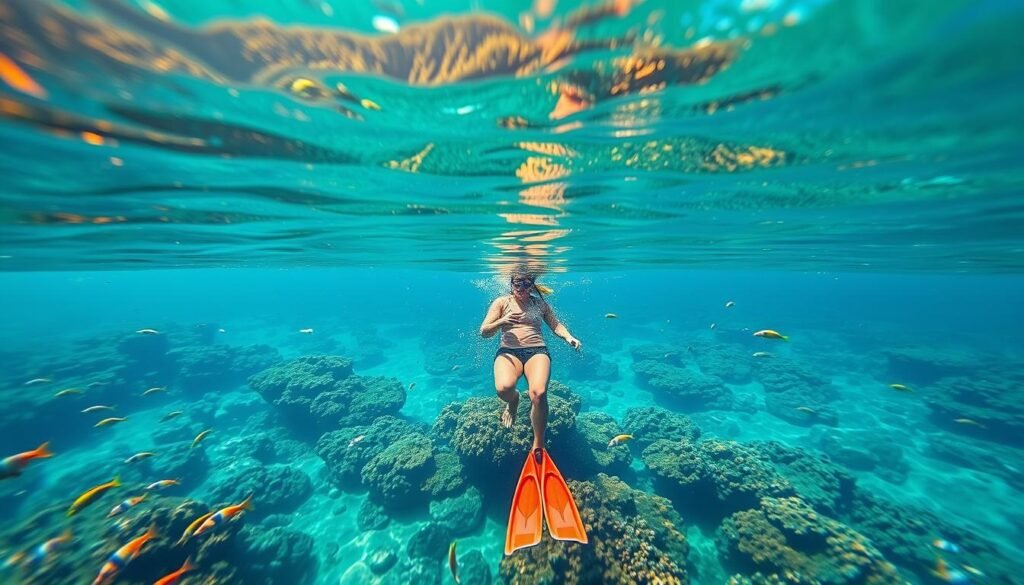
Morning snorkel runs became my favorite ritual; calm water and bright fish make early starts worth it. I usually plan the first swim for visibility and easier parking near the shore.
Where I go: Poipu, Lydgate, and Anini
Poipu Beach delivered frequent reef fish and occasional turtles. It’s my pick in winter months when north swell picks up.
Lydgate Beach Park has enclosed ponds that are perfect for beginners and families. I often start here for a gentle introduction.
Anini Beach offers a long, calm shelf and excellent coral. Expect a short swim offshore; mark landmarks so you keep your bearings.
Gear, timing, and safety
I rent mask and fins on day one and rinse gear every night. Mornings give the clearest water, less wind, and a better chance a summer tour will include a Nā Pali snorkel stop.
- Gear strategy: rent early, keep for the week, rinse daily.
- Safety note: watch currents, use proper entry points, and swim with a buddy.
- Turtle etiquette: admire from distance and never block an animal’s path.
“I prefer first-light swims — calmer seas reveal the reef life best.”
Rivers and waterfalls: kayak the Wailua to Secret Falls
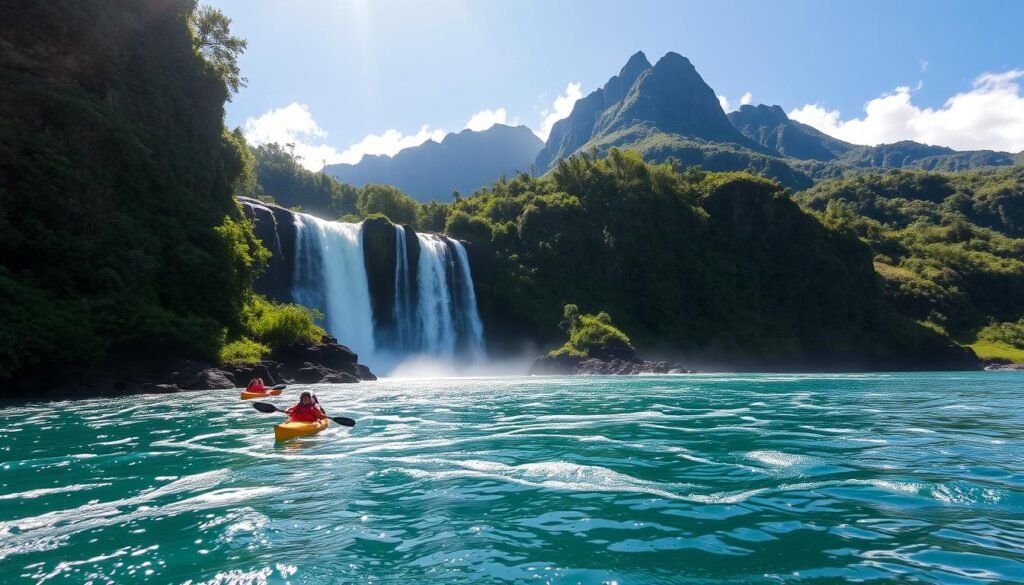
I paddled an easy upstream stretch on the Wailua and felt the forest close around us as the river narrowed. The route is straightforward: about 2 miles of mellow paddling, then a short hike that becomes muddy and rooty.
Route overview: paddle miles, muddy trail, and footwear that works
The paddle is roughly 2 miles each way. Expect a ~1.25-mile muddy trail one way from the put-in to Secret Falls (Uluwehi). Wear hiking sandals with tread and secure straps.
A trekking pole or walking stick helped my balance on slippery roots and river rocks.
Why I book a guided tour: safety, culture, and logistics
I chose a guided option for cultural context, route-finding, and safety. Guides watch river levels and warn if conditions shift during wetter months.
Self-guided rentals are available, but I valued the local stories and no-guesswork at branching paths.
- Pace snacks and water for the paddle and hike.
- Pack a dry bag for phone and camera; keep straps snug.
- Start early to beat crowds — more peaceful photos and fewer people at the falls.
“The fall revealed itself after a short muddy push; lingering a few minutes paid off with quiet light.”
After the waterfall, I rinsed at a nearby beach and grabbed a casual lunch. That easy rinse-and-recover capped the adventure without burning the afternoon.
| Segment | Distance | Conditions | My tip |
|---|---|---|---|
| Paddle (round trip) | ~4 miles total | Calm but can rise quickly | Check river forecast; bring life vest |
| Hike (one way) | ~1.25 miles | Muddy, rooty, slippery | Wear sandals with true tread; use a pole |
| Guided tours | Varies | Includes culture and safety | Best for first-timers or higher river flow |
| Best timing | Morning | Fewer people; calmer light | Arrive early for quieter photos |
Botanical gardens and cultural stops on the Garden Island
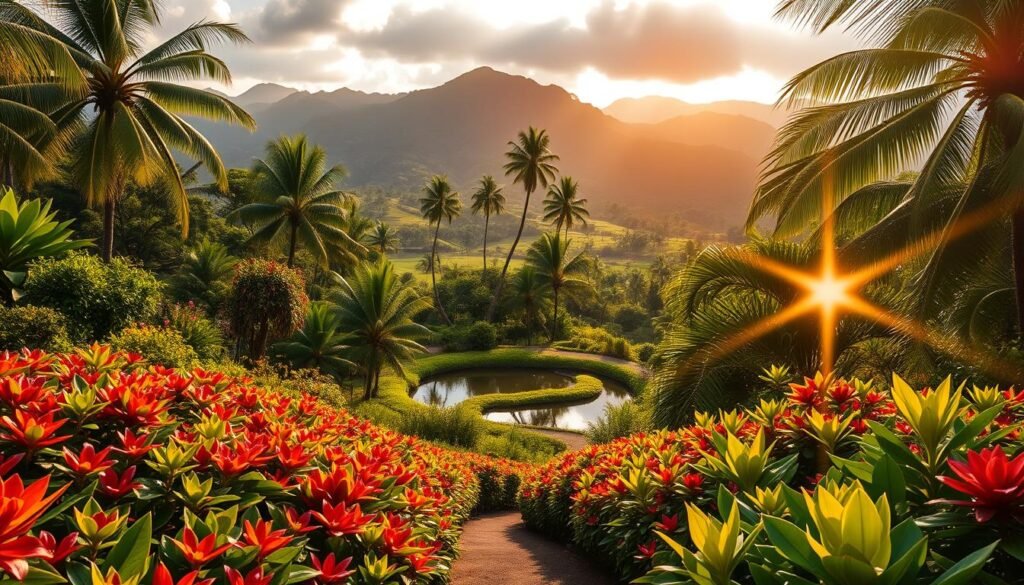
I plan an easy botanical loop that fits a half day and leaves sunset beach time untouched.
Start at Limahuli Garden & Preserve on the North Shore for layered history, terraced lo‘i, and a Nā Pali backdrop that feels like a living classroom. The guides explain native plants and cultural practices in a way that sticks.
Allerton and McBryde — Lāwaʻi Valley pair
Allerton is guided-only and focuses on landscape art and heritage. McBryde offers self-guided options and deeper botanical collections.
Pairing them in one day works well: book the Allerton tour first, then stroll McBryde at your own pace. Look for the film-famous fig roots and a small waterfall that always steals a few extra minutes.
Princeville gardens and a sweet twist
Princeville Botanical Gardens runs guided tours with a short chocolate tasting. That food stop adds a tasty layer to plant learning and makes the visit feel indulgent without being long.
Kid-friendly wildcard
Na ʻĀina Kai in Kīlauea has sculpture-rich grounds and a children’s garden. It’s an easy win for families who want playful exploration.
“Gardens shine after rain — colors pop and the air smells fresh. I plan visits around brief showers when I can.”
- My circuit: Limahuli → Allerton (guided) → McBryde (self-guided) → Princeville tasting for a relaxed day.
- Reservation tip: book tours and tastings ahead so you can stack places without rushing.
Eat and drink: my favorite local bites, coffee, and treats
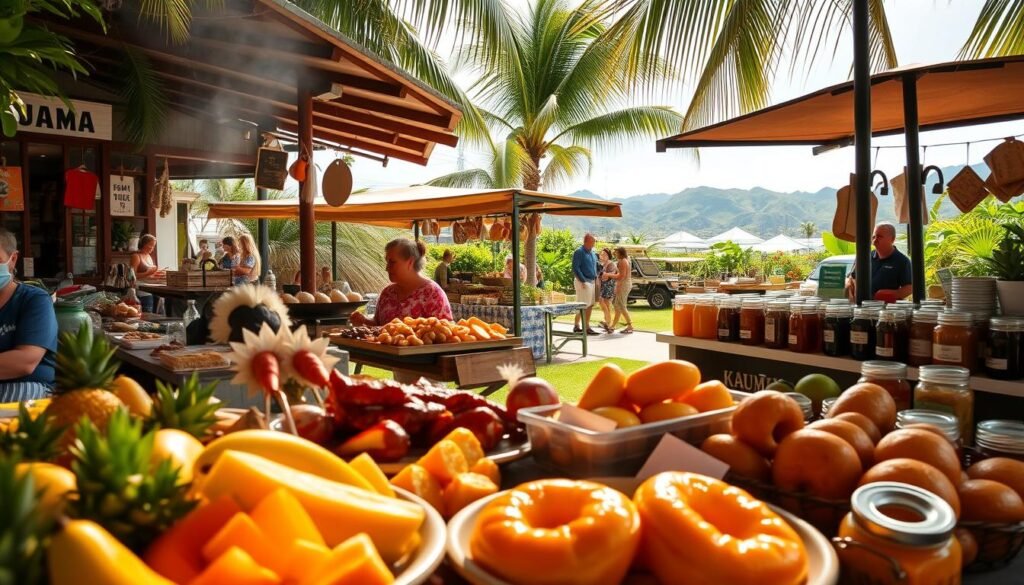
Meal breaks became mini-adventures—grab-and-go bowls, roadside burritos, and a steady coffee run. I leaned on a short list of reliable food stops that matched my pace and route around the island.
Da Crack Mexican Grinds — trail-day burritos
Da Crack in Poipu is my go-for when I need a hearty burrito before a long hike. It’s build-your-own, fast, and perfect for a scenic roadside stop before the Waimea Canyon loop.
Kenji Burger — post-adventure happy hour
Kenji Burger became one favorite for cooling off after hot trails. Multiple locations, creative burgers, and a value-forward happy hour make it an easy unwind spot with cold drinks and plenty of seating.
Aloha Roastery — coffee on the move
Aloha Roastery (Līhuʻe and Kapaʻa) kept my mornings running. I grabbed espresso and whole beans to bring home; for beans, I favored 100% Maui or Kauaʻi picks when I wanted island flavor that travels well.
Kalalea Juice Hale — the King Kong açaí bowl
The King Kong bowl at Kalalea Juice Hale turned into my early routine before North Shore outings. It’s fresh, filling, and easy to eat on the sand or at a nearby lookout.
- Peak times: order ahead when possible—lunch and late afternoon fill up fast.
- Pairing ideas: burrito + roadside lookout, açaí + beach stop, burger + cold drink after a big hike.
- Why I sample widely: spots are spread out, so food becomes part of the plan rather than a long detour.
“Small, reliable food stops kept the day moving and made each route feel effortless.”
Seasonal and family-friendly picks
During winter months I often aim for a boat vantage first and let shore plans fill the afternoon.
Whale watching and best vantage points
Humpback whales arrive from Alaska each winter, and the clearest views are usually from a boat. On calm mornings I also scan roadside overlooks for quick spouts at low effort.
My tip: book a morning cruise for the best light, then save the afternoon for calmer land activities.
River paddles, protected pools, and easy hikes with kids
I build a family-first day around safe water and short walks. A Wailua river kayak is mellow with outfitters handling logistics.
Lydgate beach park has enclosed ponds that are perfect for little swimmers. Then I pick Kuilau Ridge or Sleeping Giant for a short, dry trail that keeps kids engaged.
“Start early, plan a low-commitment midday break, and be ready to pivot to the driest microclimate.”
- South side often stays drier in winter—use it as a weather backup.
- Reserve Hāʻena state park access and shuttles ahead when visiting the North Shore.
- Pack snacks, dry layers, and a small first-aid kit so the whole family stays comfortable.
Practical planning: permits, shuttles, parking, and respecting the island
I learned that booking a shuttle early often makes the rest of the day feel effortless. A little prep secures access, reduces wait, and frees up more time for views.
Hāʻena access and shuttle rules
Hāʻena State Park requires advance parking or a Waipā shuttle reservation. The shuttle runs from designated lots and costs about $40 per person, which I book ahead for predictable timing.
Car safety, beach gear, and Leave No Trace
Car break-ins happen at trailheads and beaches. I never leave valuables visible, remove bags from seats, and avoid obvious rental markers on the vehicle.
On beaches, one person stays with gear or each swimmer carries only what they can afford to lose. Pack out trash, stay on marked routes, and respect closures after heavy rain.
Timing, weather, and microclimates
Winters bring quick showers and patchy microclimates. I chase the driest corner, ignore “all-day” forecasts, and keep a flexible window for hikes or beach stops.
“Book shuttles and lots early, travel light, and leave each place cleaner than you found it.”
| Item | Typical fee | My tip |
|---|---|---|
| Hāʻena State Park access | Advance parking or Waipā shuttle (~$40 per person) | Reserve shuttle early; use designated lots |
| Waimea/Kōkeʻe parking | $10 park fee + $5 per person | Batch lookouts and short trails to maximize paid parking |
| Car safety | — | Hide gear, avoid rental “tells,” lock doors |
Conclusion
I learned quickly that the island rewards small buffers: extra minutes often turn plans into lasting memories. Say yes to early starts and golden-hour finishes; that timing made my trip feel exceptional.
My list of best things I’d repeat: a Nā Pali tour, a Waimea Canyon sunrise-to-midday loop, and a North Shore sunset. Those three highlights became one best rhythm for any visit.
Plan a little time for permits and shuttles and keep a loose day for weather pivots. Mix high-adventure days with slow coffee breaks, short beach parks, and garden walks. Respect wildlife, tread lightly, and the island will reward you with one best surprise after another.


